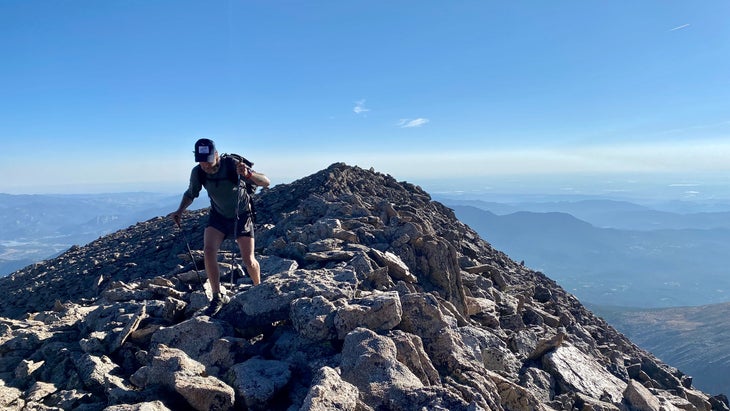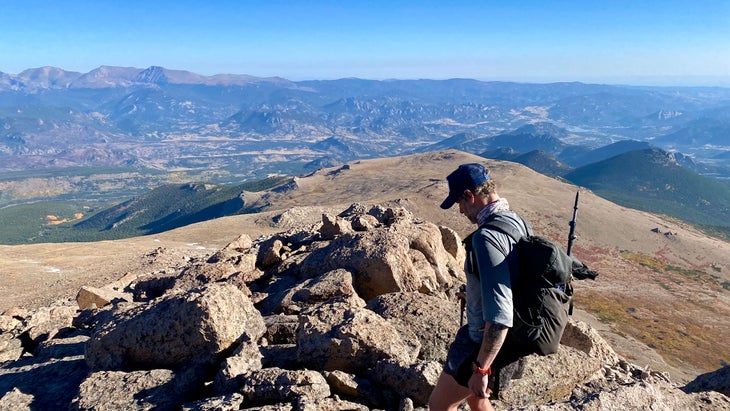���ܳٲ������’s Trail Magic hiking columnist Grayson Haver Currin is attempting to bag the triple crown of hiking. He’s already thru-hiked the Appalachian Trail and Pacific Crest Trail, with one more to go: the Continental Divide Trail. He’ll share notes from the field as he walks with his wife for the rest of the year. Tune in on to follow his journey.
In 30 days, I have climbed nearly 130,000 feet. If I were in Manhattan, rather than heading south through Montana and Idaho along the Continental Divide Trail (CDT), I could have easily done the same thing just by running up and down the stairs at the Empire State Building, twice a day for the same time period.
Some of this gain has been totally unremarkable. I’ve picked up 100 feet here, 200 there on spans of the CDT that have mostly felt flat. But some of these ascents during my first 700 miles along my thru-hike have been spectacular, not only for their steepness but the beauty both at the peak and along the route to reach it. There was the Triple Divide Pass, for instance, near where the waters of North America split for the Atlantic, Pacific, or Arctic ocean, a hydrological oddity like few others. Or there was the panoramic push along switchbacks above Storm Lake to Goat Flats, a sweeping and windswept saddle speckled by larches, high in the Anaconda-Pintler Wilderness. It felt like another world. Climbing, at least as I see it, is the psychedelic of hiking, a gateway to a dimension you previously couldn’t imagine.
But I know that climbing can be daunting, too, taxing not only for your legs and lungs but also the brain. “How far and how long,” hikers often wonder on the uphill, “can life go on like this?” I’ve been there, of course; these days, as we continue toward Mexico mile by mile, I ask myself this at least once a day. In five years of thru-hiking, however, I’ve developed some strategies—some mental and others physical, some predictable and others zany—to help myself more efficiently hike uphill.
Remember: the more you do it, the better you get. The better you get, the easier the views from the top come.
Beginner-Friendly Tips for Hiking Uphill
1. Churn your feet to optimize your inertia.
I was an awful high-school football player, too small and soft for my obligatory position on the offensive line and too slow for anything else. But I internalized at least one invaluable lesson from those days of trying (and largely failing) to open holes for running backs: Keep your feet moving, so that you remain more reactive and don’t waste inertia energy. That’s how I climb, too, with my legs in constant motion, as if pushing the pedals of an imaginary bicycle. When going uphill, it’s all too tempting to treat each step like a single act, sinking so deep into each bend of the knee that it feels like you’re about to stop with each step. Fatigue makes this more enticing as you ascend, but avoid it. Spring into shorter steps, almost as if you’re (slowly) about to leap into the next one. This keeps the necessary muscles ready and engaged, glutes to toes, and you won’t waste momentum. Remember this when it comes to climbing strides: Short and steady, not long and labored.
2. Don’t forget your arms; use your trekking poles to your advantage.
As you climb, your legs may burn, cramp, or generally ache. Why not help them? While your shoulders may be supporting your backpack, the rest of your arms are free to propel you. All too often, I see people bent over their hiking poles as they climb, as if they’re leaning on the frames of a walker in a retirement facility. Get at least one of those poles behind you, and push forward with it on every step. Think of it as a bonus thruster, able to alleviate at least a bit of your struggle. (Speaking of which, I’ve been loving these new . They’re super strong relative to their weight, and not flimsy like many of their carbon fiber brethren.) And if you’re foregoing poles, swing your arms forward with your steps, almost as if you’re lunging for the peak. Will you look goofy, as if you’re marching up a mountain in military fashion? Totally. Will it help? Probably.

3. Microdose your breaks and keep your backpack on.
On a recent ascent so extended it felt as if I were walking up a broken escalator to nowhere, I spotted a fellow hiker at the end of a switchback having a wrestling match with his backpack. He’d thrown it down to take a break, then collapsed in the dirt beside it for an extended spell. Then, he struggled to start again. Don’t do that. Take smaller breaks more often, and please leave your pack on. Lean on your hiking poles or rest with your pack against a tree long enough to catch your breath and for the sweat to slow just a little (maybe a minute), then proceed. A good way to time this? Put on a favorite album of four-minute songs; pause for a microbreak every two tracks, and begin again when the chorus of the third hits.
4. Skip the excess water; filter as you go.
How many times have I seen a hapless day hiker plodding up the side of a mountain sporting a backpack stuffed with two (very full) one-liter Nalgenes? Enough that I feel compelled to mention it here. That, after all, is more than five pounds of stuff—liquid and bottle included. Most climbs will have at least one water source, clearly delineated in mobile apps, digital maps, or online trip reports. Use it. Leave the extra Nalgene in your car, and climb with the indomitable Sawyer Squeeze, a two-ounce tube that filters water that might not even look clean. (This frees up space in your pack for electrolyte powder, snacks, layers, and other things, too.)
5. Fuel up along the way.
Snack as you climb, and enjoy some sugar as you do. Is it the vanity of fitness that causes folks to forego food as they ascend, convinced that, if they wait until the summit before cracking open those gummy bears, they’ll arrive with perfect abs or something? Is it the promise of a good-old gorge at the end of a long day outside? I don’t know, really, but give your engine the calories it needs before you bonk. Think: simple sugars your body craves. Jellybeans, pineapple rings, gummy bears, and caffeinated packets of Gu are some of my favorites. Bottom line? Eat enough to burn as you churn your way up the hill.
6. Move from target landmark to target landmark.
I learned to run well from a long-distance cyclist who once offered this perfect insight during my early days of sprinting hills: As you hit the hill’s base, pick a landmark a short distance up—say, a stump, or a crack in the asphalt—and power toward it. Just before you reach it, pick another landmark and repeat. Do this long enough, and you’ll be speeding off the crest just as this game gets fun. I still run this way, and I’ve found it to be the ideal hiking trick, like a solution to Zeno’s dichotomy paradox that actually gets you where you want to be, which is the downhill.

7. Engage your mind to hike uphill.
As you climb, the trail will doubtlessly bend and dip as you tackle the terrain. But your task essentially remains linear, as you increase your elevation over a set distance. I have long tricked my brain into thinking otherwise with a strategy that I recognize may make me sound mental: I count out of order. Quietly in my head or just under my breath, I’ll start with the basics of “one, two, three” but soon skip in the count to wherever I fancy, maybe jumping 10 digits at a time or perhaps multiplying the last two numbers to put me somewhere else entirely on the continuum of integers. Sometimes, I’ll even count backwards. I look for patterns in these numbers and try to think about why I’ve stumbled upon them. Before I know it, I’ve knocked off another 500 feet of gain. Essentially, let your mind wander and get away from the straightforward and sometimes strenuous task at hand. The Uncounting Game works for me, though other mind-game approaches are endless, from audiobooks and mantras to counting trailside squirrels. Pick a distraction, and go.
8. Get your drone on, musically.
Usually people think music meant for climbing hills should be fast and loud, like power-up anthems that will push you forward with a surge of positivity. Sure, I do that. But as with The Uncounting Game, I also like to let my thoughts wander during my climbs, to forget at least a little bit what I’m doing until reality blurs into a haze. So instead, I listen to drone—that is, mesmerizing, beatless stretches of sound that sometimes evolve very little over the course of an hour. By paying attention to near-microscopic changes, like suddenly sensing the different way a violinist is holding the bow, I slip out of current drudgery. Drone music exists in most musical forms, from heavy metal and electronic to string bands and choirs, so you can find one that fits your mood.
On the CDT, my go-to drones for climbing the first 130,000 feet have been: Kali Malone’s , a massive work for organ; Earth’s , a foundational document of drone metal; Kalia Vendever’s , a gorgeous little set of trombone hums; and Éliane Radigue’s , an absorbing meditation of circuits and bells. You can keep the volume down, too, to listen for the birds and bears as you ascend.


